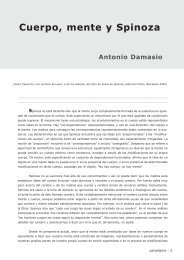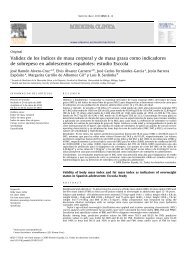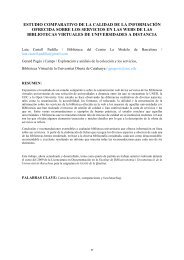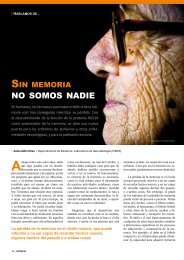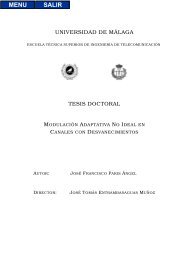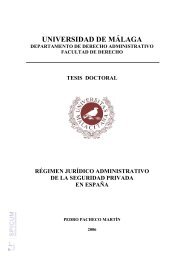Papel de las actividades superóxido dismutasa y catalasa en la ...
Papel de las actividades superóxido dismutasa y catalasa en la ...
Papel de las actividades superóxido dismutasa y catalasa en la ...
You also want an ePaper? Increase the reach of your titles
YUMPU automatically turns print PDFs into web optimized ePapers that Google loves.
RESULTS AND DISCUSSION<br />
necessary, this <strong>la</strong>ck of a new superoxi<strong>de</strong> dismutase induction could be due to the<br />
pres<strong>en</strong>ce of only one sod g<strong>en</strong>e, sodB, <strong>en</strong>coding ferric superoxi<strong>de</strong> dismutase (Lynch and<br />
Kuramitsu, 2000).<br />
In the same way all strains, un<strong>de</strong>r all assayed culture conditions, show only one<br />
band of cata<strong><strong>la</strong>s</strong>e activity, with simi<strong>la</strong>r electrophoretic mobility to the band <strong>de</strong>scribed by<br />
Barnes et al. (1999a). Treatm<strong>en</strong>t of cata<strong><strong>la</strong>s</strong>e gels with inhibitors indicates that this<br />
bacterium contains an iron-cofactored <strong>en</strong>zyme, because cata<strong><strong>la</strong>s</strong>es with manganese retain<br />
its activity after treatm<strong>en</strong>t with azida and cyani<strong>de</strong>, but they are inhibited with mercuric<br />
chlori<strong>de</strong> (Kono and Fridovich, 1983; Allgood and Perry, 1986; Barnes et al., 1999b).<br />
Despite none assayed culture condition induced synthesis of more than one<br />
superoxi<strong>de</strong> dismutase or cata<strong><strong>la</strong>s</strong>e iso<strong>en</strong>zyme, differ<strong>en</strong>ces in the int<strong>en</strong>sity of the bands<br />
and activity levels, after spectrophotometrically quantification, are observed. These<br />
results are in agreem<strong>en</strong>t with those obtained by Barnes et al. (1999a), who also <strong>de</strong>tected<br />
differ<strong>en</strong>ces in cultures carried out un<strong>de</strong>r iron replete and <strong>de</strong>pleted conditions and highand<br />
low- aerated broths. The quantification of both superoxi<strong>de</strong> dismutase and cata<strong><strong>la</strong>s</strong>e<br />
activities carried out in this study corroborated that differ<strong>en</strong>t band int<strong>en</strong>sities<br />
correspon<strong>de</strong>d to variations in the levels of activity. The lowest levels of superoxi<strong>de</strong><br />
dismutase activity and cata<strong><strong>la</strong>s</strong>e are <strong>de</strong>tected in bacteria grown un<strong>de</strong>r iron-restricted<br />
conditions, attributable to the ferric nature of P. damse<strong>la</strong>e subsp. piscicida superoxi<strong>de</strong><br />
dismutase and cata<strong><strong>la</strong>s</strong>e. Un<strong>de</strong>r iron-limiting conditions the virul<strong>en</strong>t strain shows higher<br />
activity levels of superoxi<strong>de</strong> dismutase and cata<strong><strong>la</strong>s</strong>e, than the non virul<strong>en</strong>t strain. This<br />
result indicates the relevant role of iron uptake mechanisms for superoxi<strong>de</strong> dismutase<br />
and cata<strong><strong>la</strong>s</strong>e activity. Thus, a microorganism capable to obtain iron from the host would<br />
be able to express higher levels of antioxidant <strong>en</strong>zymes and could <strong>de</strong>compose<br />
superoxi<strong>de</strong> and hydrog<strong>en</strong> peroxi<strong>de</strong> radicals g<strong>en</strong>erated by the host. The importance of<br />
superoxi<strong>de</strong> dismutase as antioxidant <strong>en</strong>zyme and its contribution to bacterial virul<strong>en</strong>ce<br />
have be<strong>en</strong> <strong>de</strong>monstrated in several bacterial species such as Listeria monocytog<strong>en</strong>es<br />
(Welch et al., 1979), Shigel<strong>la</strong> flexneri (Franzon et al., 1990) or A. salmonicida (Barnes et<br />
al., 1999a), however its role in P. damse<strong>la</strong>e subsp. piscicida is not very clear and in the<br />
99




